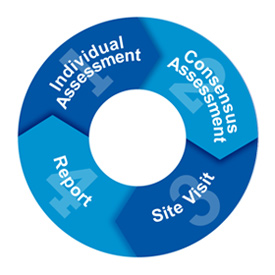APPLICATION, ASSESSMENT, AND FEEDBACK
At the national Baldrige level and in most state quality award programs, organizations submit a 50-page application with an additional 5-page Organizational Profile as a preface.
A key to success in writing an effective application is to ensure alignment among the Organizational Profile, the Process Categories and the Results Category. An effective Baldrige application is more than a set of answers to the Baldrige Criteria questions: your Baldrige application should be a formal description of how your organization operates.
Baldrige assessments are confidential. The Baldrige process is focused on helping your organization improve: your participation is not reported to anyone outside the Baldrige program unless you win the Baldrige Award. At that point you share your performance excellence journey and best practices as a method of helping advance performance excellence.
APPLICATION COMPONENTS
There are three components to a Baldrige application:
1. Organizational Profile
(Answers the question: “What is most important to us?”)
Writing an Organizational Profile is the first step in your Baldrige journey. If you do nothing but complete the Profile, gaining senior leadership input and agreement, you will have a useful tool that helps focus your organization’s efforts.
The Profile is a snapshot of your organizational environment and relationships, core competencies, competitive environment, strategic challenges and advantages, and performance improvement system.
2. The Process Categories
(Answers the questions: “What do we do, how do we do it, and how do we improve?”)
There are six Process Categories addressed through this component:
- Leadership
- Strategy
- Customer
- Measurement, Analysis, and Knowledge Management
- Workforce
- Operations
Baldrige Examiners assess the maturity of your organization’s systems and processes (Categories 1-6) using ADLI:
- Approach—what do you do?
- Deployment—how extensively do you do it?
- Learning—how do you evaluate and improve?
- Integration—how well is the approach aligned with your organizational needs?
3. Results Category
(Answers the question: “Were we successful?”)
The Results Category responses address the following areas:
- Product, Service, and Process Outcomes
- Customer-Focused Outcomes
- Workforce-Focused Outcomes
- Leadership and Governance Outcomes
- Financial and Market Outcomes
Baldrige Examiners assess the maturity of the Results (Category 7) by considering how you address LTCI:
- Levels—What is your current performance?
- Trends—What is your performance over time?
- Comparisons—What is your performance against appropriate comparisons?
- Integration—How well do performance results address key customer, market, and process requirements?
A SYSTEMIC APPROACH TO APPLICATION
Any organization that is working on continuous improvement has made progress along the Baldrige or EFQM journey, whether they call it that or not. Core Values Partners will help you move through four stages, which may repeat throughout your journey as you advance towards organizational performance excellence:
- Awareness—Key to the success of a Baldrige or EFQM effort is to ensure understanding and commitment by the senior leadership team. Commitment by senior leaders isn’t an option—it is a requirement!
- Assessment—An initial assessment can help you determine where your organization stands against the Baldrige or EFQM Criteria by building understanding and identify initial performance gaps. There are multiple methods to accomplish this assessment—on-line, paper, interviews, or a combination of all. This assessment can also be a great way to introduce Baldrige to your organization.
- Application—Develop and submit a Baldrige or EFQM application. A team-based writing approach can accelerate the application process. The application writing process helps you identify Strengths and Opportunities for Improvement that can be immediately addressed – before you ever submit your application!
- Advancement—Based on results of your application, you can focus your improvement efforts by determining how to sustain your Strengths and prioritize and address your Opportunities for Improvement.
AFTER SUBMITTING YOUR APPLICATION
What happens “behind the scenes” after an application is submitted?
- Individual Assessment. Trained Baldrige or EFQM Examiners spend 40-50 hours each assessing your application and compiling strengths and OFI comments for each area as they score your application against the Baldrige or EFQM Criteria.
- Consensus Assessment. The Examination team consolidates comments and determines a score through team consensus. These consensus scores help the Baldrige or EFQM Judges determine who moves on to the Site Visit.
- Site Visit. For those who achieve this step, a team of Baldrige or EFQM Examiners visits your organization for an in-depth assessment. Site visits last 3-4 days and delve deeply in your processes and culture through focused interviews and document and results review.
- Feedback Report. Applicants receive a feedback report detailing actionable strengths and OFIs, regardless of the assessment level achieved. Even award-winning organizations receive a feedback with approximately 40-50 OFIs.

